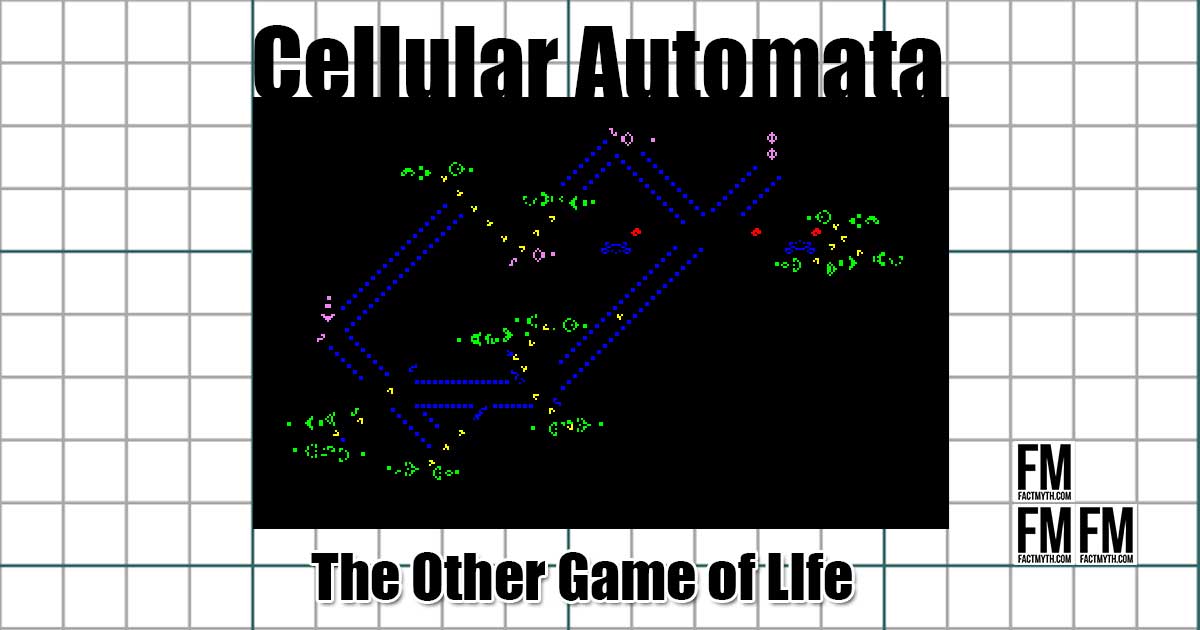The Game of Life and other cellular automata work well as a model for how complex systems can evolve and replicate based on a simple rule-set. With a broad brush we can trace lines between the game of life, all systems, the physical universe we live in, and beyond. So remember kids, video games can make you smarter and a simple and elegant rule-set is always best.
Conway’s Game of Life Models Evolution fact

The Game of Life, Just a Little Math and Some If / Then Commands
Conway’s Game of Life is a simple rule-set that models the evolution of systems. It’s a “zero-player” computer program that demonstrates “cellular automata”.[1]
In simple terms, the Game of Life shows that a system can be created which “automatically” produces copies of itself based on an initial state with a few basic rules. Although the game was invented in 1970, and a fully replicating pattern wasn’t discovered until the 2010’s.
A rule-set that allows for a cell-based automation is called a “cellular automaton.” Cellular automata can simulate a variety of real-world systems, including biological and chemical ones. The concepts can be used to improve our understanding of complex systems and how to form complex systems out of simple parts.[1][2]
Conway’s game of life (1970). It’s almost like we can break down the existence of all systems to mathematic algorithms. Almost.FACT: You can “play” Conway’s Game of Life online here.
TIP: Zero player = an initial state is set and then the game plays itself based on its rule-set. The naming is Conway’s invention, it’s clever, but I argue setting a state is “playing”, and thus it’s a “single-player game” with only one actionable turn. That isn’t very catchy, though.
Does the Game of Life Actually Mimic Real Life?
Despite the sheer awesomeness of the Game of Life, there are big differences between Conway’s game and the actual evolution of physical systems. The Game of Life should be understood as analogous to other systems, rather than an exact mimicry of evolution or a specific physical system like human evolution or even genetic evolution in general.
Also, it should be understood that since Conway’s Game of Life was published in 1970 scientists have continued to study and improve technology in the field of cellular automata. Technology like nano-bots (simple bots that work together in a swarm to mimic complex behaviors, use principles of cellular automata).
Inventing Game of Life – Numberphile. How can we colonize distant planets? Taking humans and equipment probably won’t work, but if we could automate the process say with some mitochondria and chloroplasts that automate we have something to work with.TIP: For a better understanding of how elementary particles work (core systems) go here, for a better understanding of how cells evolved on earth go here, for a better understanding of how systems work go here.
The Rules of the Game of Life
The game of life takes place on square cells on an infinite two-dimensional grid (computerized, or not). There are two states for cells, alive or dead. Every cell interacts with the 8 surrounding cells. At each “frame” (interval/round of gameplay), the following steps take place in order:
- Any live cell with fewer than two live neighbors dies as if caused by under-population.
- Any live cell with two or three live neighbors lives on to the next generation.
- Any live cell with more than three live neighbors dies, as if by over-population.
- Any dead cell with exactly three live neighbors becomes a live cell, as if by reproduction.
The initial state of the game, not the ruleset, is the only controllable factor in the Game of Life. If you think this analogous to how our universe was born, then you can understand why people still talk about a zero-player computer game from the 70’s.
Who is John Conway?
John Horton Conway was studying cellular automata (automated cell-based rule-sets) and wanted to devise a program that could build copies of itself.
He devised the Game of Life based on John von Neumann’s attempts to find such a hypothetical machine for colonizing distant planets. The timing was right and by 1970, his idea was published in the October 1970 issue of Scientific American, in Martin Gardner’s “Mathematical Games” column.[1]
The Game of Life can be used to create also sorts of interesting automata like Tetris shapes, pulsars, and importantly “glider guns” that shoot out other cells resulting in the game creating copies of in-game objects (and even itself with the right initial state).
The first initial state that could fully replicate the game and its rule-set was discovered in 2010.[3]
Does John Conway hate his Game of Life?